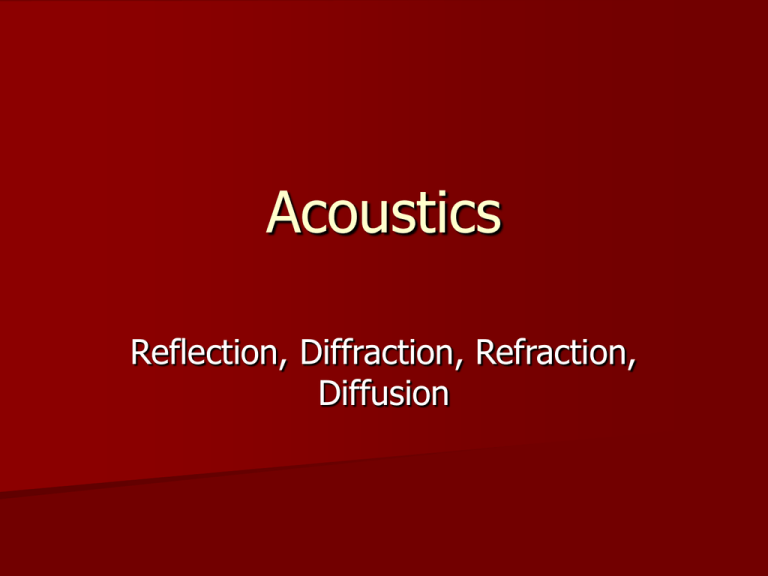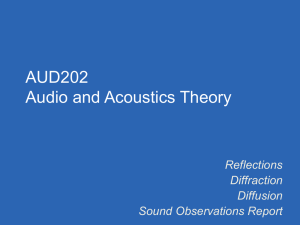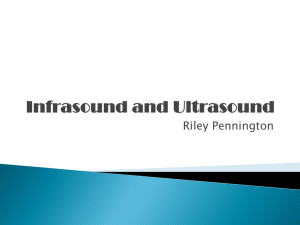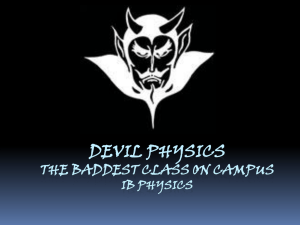Reflection, Diffraction, Refraction, Diffusion
advertisement

Acoustics Reflection, Diffraction, Refraction, Diffusion Reflection of Sound If a sound is activated in a room, sound travels radially in all directions. As the sound waves encounter obstacles or surfaces, such as walls, their direction of travel is changed, i.e., they are reflected. The diagram shows the reflection of waves from a sound source from a rigid, plane wall surface. Reflections from Flat Surfaces Like a mirror, the reflected wavefronts act as though they originated from a sound image. The image source is located the same distance behind the wall as the real source is in front of the wall. Below 300 – 400 Hz, sound is best considered as waves. Sound above 300 – 400 Hz is best considered as traveling in rays. The mid/high audible frequencies have been called the specular frequencies because sound in this range acts like light rays on a mirror. Angle of Reflection Sound follows the same rule as light: the angle of incidence is equal to the angle of reflection. The pressure at the face of a perfectly reflecting surface is twice that of a perfectly absorbing surface. Reflections from Convex Surfaces Reflection of plane wavefronts of sound from a solid convex surface tends to scatter the sound energy in many directions. This amounts to a diffusion of the impinging sound. Reflections from Concave Surfaces Plane wavefronts of sound striking a concave surface tend to be focused to a point. The precision with which sound is focused is determined by the shape of the concave surface. Reflections from Parabolic Surfaces A parabola has the characteristic of focusing sound precisely to a point. This concept is used in microphone design to create highly directional microphones known as parabolic mics. Standing Waves The concept of standing waves is directly dependent on the reflection of sound. A standing wave is a resonance condition in an enclosed space in which sound waves traveling in one direction interact with those traveling in the opposite direction, resulting in a stable condition. Reflection of Sound from Impedance Irregularities Mismatches in impedance give rise to reflections, which cause numerous undesirable effects, but can sometimes be desirable effects instead. Example: when a sound wave (noise) traveling in an air conditioning duct suddenly encounters the large open space of the room, the impedance mismatch reflects a significant portion of the sound back toward the source. This is considered a desirable effect due to the fact that the air conditioning noise is reduced. Diffraction of Sound Wavefronts and rays of sound travel in straight lines, except when something gets in the way. Obstacles can cause sound to be changed in its direction from its original path. The process by which this change of direction takes place is called diffraction. Diffraction and Wavelength Obstacles capable of diffracting (bending) sound must be large compared to the wavelength of the sound involved. The effectiveness of an obstacle in diffracting sound is determined by the acoustical size of the obstacle. Acoustical size is measured in terms of the wavelength of the sound. Some Examples of Diffraction In figure A, the upper edge of the wall acts as a new, virtual source sending sound energy into the “shadow” zone behind the wall. In figure B, most of the sound energy is reflected from the wall surface, but that small portion going through the hole acts as a virtual point source, radiating a hemisphere of sound into the “shadow” zone behind the wall by diffraction. Diffraction by Large and Small Apertures In figure A, the arrows indicate that some of the energy in the main beam is diverted into the shadow zone. Diffraction of Sound by Obstacles In figure A the obstacle is so small compared to the wavelength that it has no appreciable effect on the passage of sound. Diffraction by Acoustic Lens Diffraction around the Human Head For frequencies 1 – 6 kHz arriving from the front, sound pressure changes around the head. At frequencies below 1 kHz, sound pressure change is negligible. Refraction of Sound Diffraction is changing the direction of travel of sound by encountering sharp edges and physical obstructions. Refraction changes the direction of travel of the sound by differences in the velocity of propagation. Refraction of Light The visual distortion that occurs when an object is placed in the water at an angle is due to refraction of the light waves in the denser medium. Refraction of Sound in Solids Sound waves traveling through materials at an angle will bend when they encounter a different material of greater or lesser density. Speed of Sound Some examples of the speed of sound based on density. Refraction of Sound in the Atmosphere The atmosphere is anything but a stable, uniform medium for the propagation of sound. The diagram shows refraction due to temperature gradients. Another Example This diagram shows refraction of sound radiated upwards. Note the “sound shadow” due to refraction near the ground. Wind Gradients Outdoors, wind usually plays a bigger role in refraction of sound. Diffusion of Sound Sound diffusion is the spreading out or scattering of sound waves or rays in many different directions. Diffusion problems are most troublesome in smaller rooms and at the lower audio frequencies. The problem with small spaces is that modal spacings below 300 Hz guarantee a sound field far from diffuse. The Perfectly Diffuse Sound Field Even though unattainable, it is instructive to consider the characteristics of a diffuse sound field. Randall and Ward have given us a list of these characteristics: – The frequency and spatial irregularities obtained from steady state measurements must be negligible – Beats in the decay characteristic must be negligible – Decays must be perfectly exponential (straight lines on a logarithmic scale) The Perfectly Diffuse Sound Field – Reverberation time will be the same at all positions in the room – The characteristic of the decay will be essentially the same for different frequencies – The characteristic of the decay will be independent of the directional characteristics of the measuring microphone Evaluating Diffusion in a Room The loudspeaker and microphone were placed in opposing corners because all room modes terminate in the corners. The fluctuations in this response cover a range of about 35 dB. Decay Beats As discussed earlier, decay beats induced by closely spaced modes cause irregularities in decay, especially at low frequencies. Exponential Decay A truly exponential decay is a straight line on a level vs. time plot. This decay shape is probably a mode or group of modes encountering low absorption. Another Example This decay shape is due to an acoustically coupled space. Adjustable Acoustics The inconsistency of decay time at lower frequencies indicates a nondiffuse condition. Room Shape The popularity of rectangular rooms is due in part to economy of construction, but it has its acoustical advantages. The relative proportioning of length, width, and height of a sound sensitive room is most important. Some shapes, like parabola, can be eliminated because they focus sound, which is the opposite of diffusion. Optimal Room Proportions This table shows several “optimal” room ratios as proposed by four different studies. Optimal Room Proportions Another study shows ideal room ratios. This study was done by Bolt and is referred to as the “Bolt Area.” Nonrectangular Rooms Splaying one or two walls of a sound-sensitive room does not eliminate modal problems, although it might shift them slightly and produce somewhat better diffusion. Flutter echoes definitely can be controlled by canting one of two opposing walls. The amount of splaying is usually between 1 foot in 20 feet and 1 foot in 10 feet. Making the sound field asymmetrical by splaying walls only introduces unpredictability in listening room and studio situations. Geometrical Irregularities Many studies have been made on what type of wall diffusors provide the best diffusing effect. Geometrical diffusors must be at least 1/7th of a wavelength before their effect is noticed. Studies have shown that the straight sides of the rectangular shaped diffusor provide the greatest effect for both steady-state and transient phenomena. Rectangular Wall Panels Rectangular sound absorbing panels with wood edges are an inexpensive way to achieve both absorption and diffusion. Convex vs. Concave Surfaces The Poly vs. Planar Diffusion Favorable reflection, absorption, and reradiation characteristics favor the use of the cylindrical surface over the planar surface. The Schroeder Diffusor Manfred Schroeder pioneered the concept of acoustic diffusors. The diagram shows his first design. Commercial Diffusors There are many companies now manufacturing various types of diffusors, available through pro audio stores, mail order, or on-line sales. The best diffusors are made by companies with years of research and experience backing their product. Choosing a product will depend on budget and specific diffusion needs. Types of Diffusors The most common types of commercially available diffusors are: – Reflection Phase-Grating (RPG) – Quadratic-Residue (QRD) – Diffractal (DFR) QuadraticResidue Diffusors RPG Diffusor Systems, Inc. is a leading manufacturer of diffusion devices. Dispersion Pattern The hemidisc pattern is shown here. More RPG Products Three different types of diffusors are shown here. Diffractal Diffusion This design utilizes three different frequency ranges of diffusion. Diffractal Diffusion Another example Diffusion in Three Dimensions Hemicylindrical and Hemispherical diffusion.











